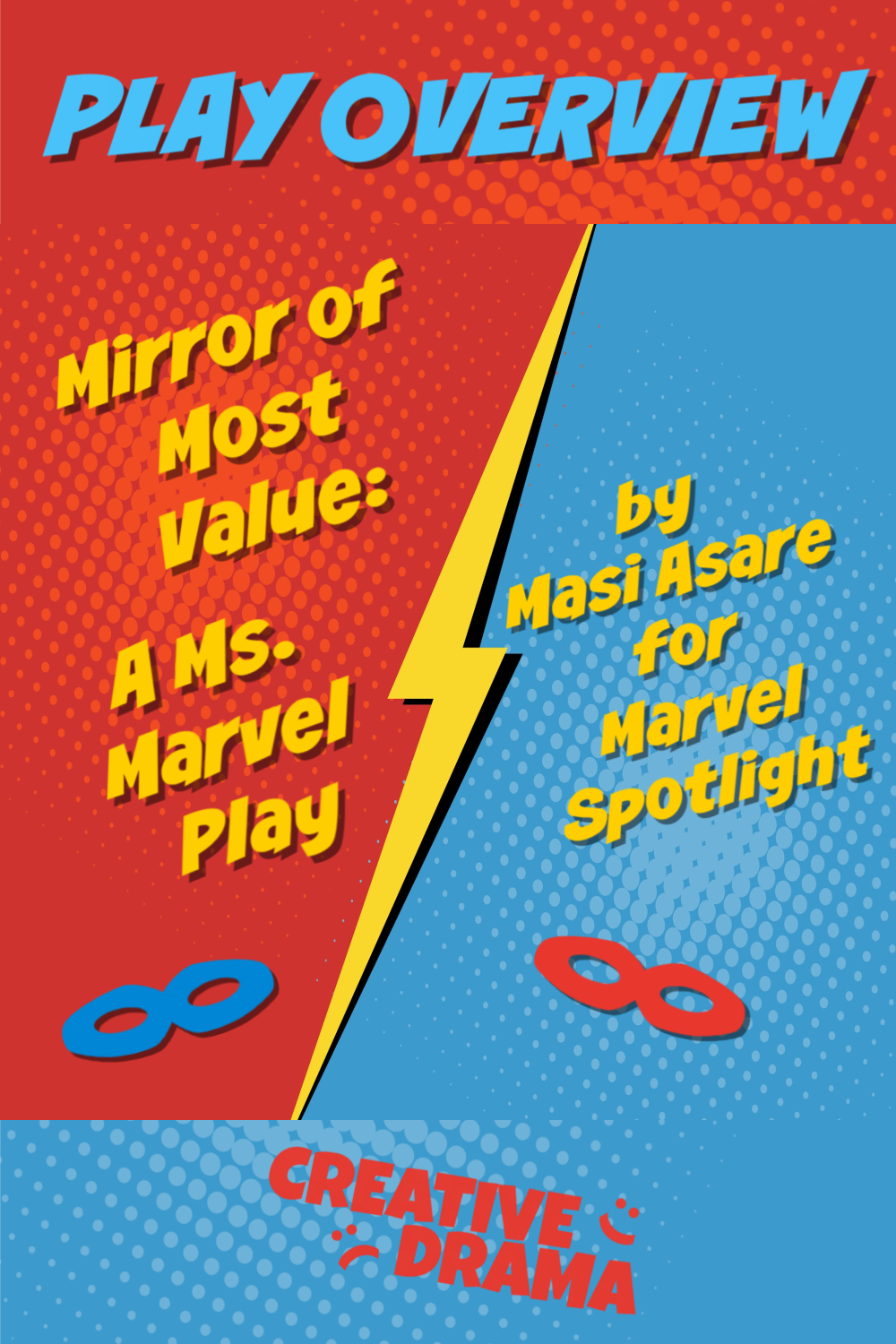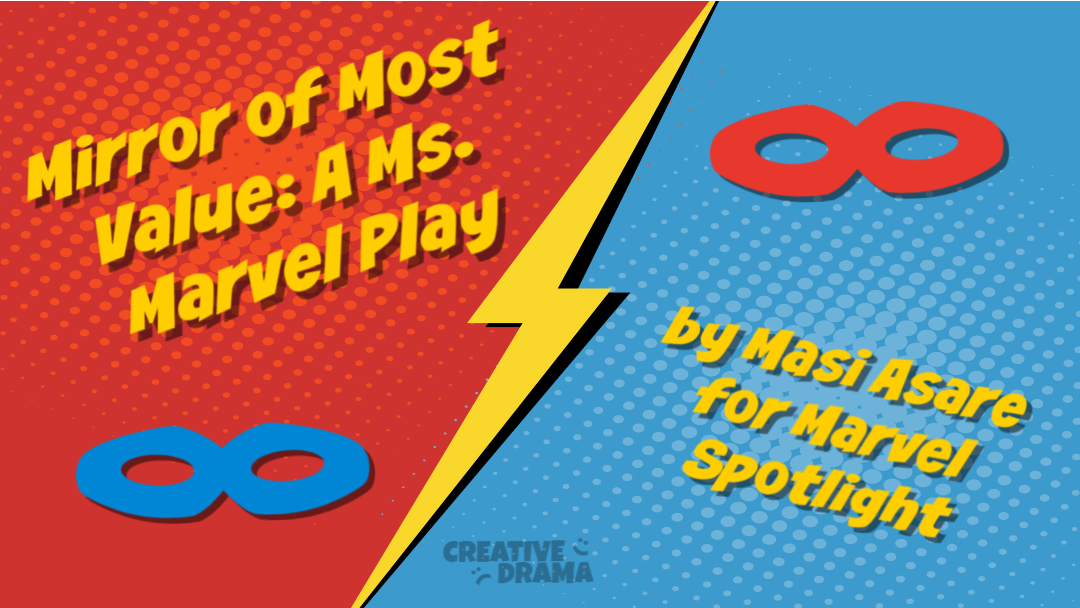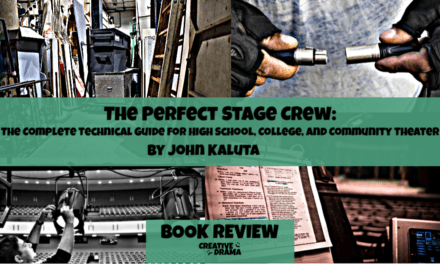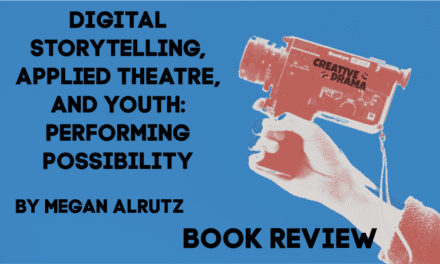With Mirror of Most Value: A Ms. Marvel Play, Masi Asare provides an opportunity for a large, diverse cast to tell the story of a rising teen superhero who’s trying to balance her secret identity and having a life in high school.
Contents
SUMMARY
TITLE: Mirror of Most Value: A Ms. Marvel Play
AUTHOR: Masi Asare
LICENSING ENTITY: Samuel French
GENRE: Comedy
PLOT: Teenager KAMALA KHAN tries to make a MS. MARVEL into a popular superhero while maintaining her grades, socializing with friends, and keeping her super identity a secret.
CHARACTER BREAKDOWN: 8 Female, 4 Male, 9 Any Gender; additional 9 ENSEMBLE roles possible; the majority of the roles are high school students
COSTUMES: Contemporary and SUPERHERO costumes (4 MS. MARVEL, 1 each of CAPTAIN MARVEL, IRON MAN, BLACK WIDOW, and DOCTOR STRANGE); one character wears a hijab
SET REQUIREMENTS: The setting is Jersey City; scenes include a bedroom with a practical window, a city deli, a science classroom, a building exterior with a fire escape; a projection screen is useful for the production
PROPS: Everyday objects: solar-powered physics projects for students to work on; a weapon (of your choosing) for a robber
STAGING CHALLENGES: The ENSEMBLE provides assistance to MS. MARVEL’s powers; some stage combat scenes and a dream sequence; how to differentiate between the “fanfic” action and the “real life” action
MARVEL SPOTLIGHT SERIES
If Harry Potter and SpongeBob can get their own stage shows, why not the Avengers? The Marvel Universe is coming to school theatres in one-act plays!
Mirror of Most Value: A Ms. Marvel Play features KAMALA KHAN as the titular hero. As MS. MARVEL, KAMALA tries to balance secretly patrolling the streets of Jersey City while keeping up her grades and friendships. Marvel knows how to appeal to their audience…
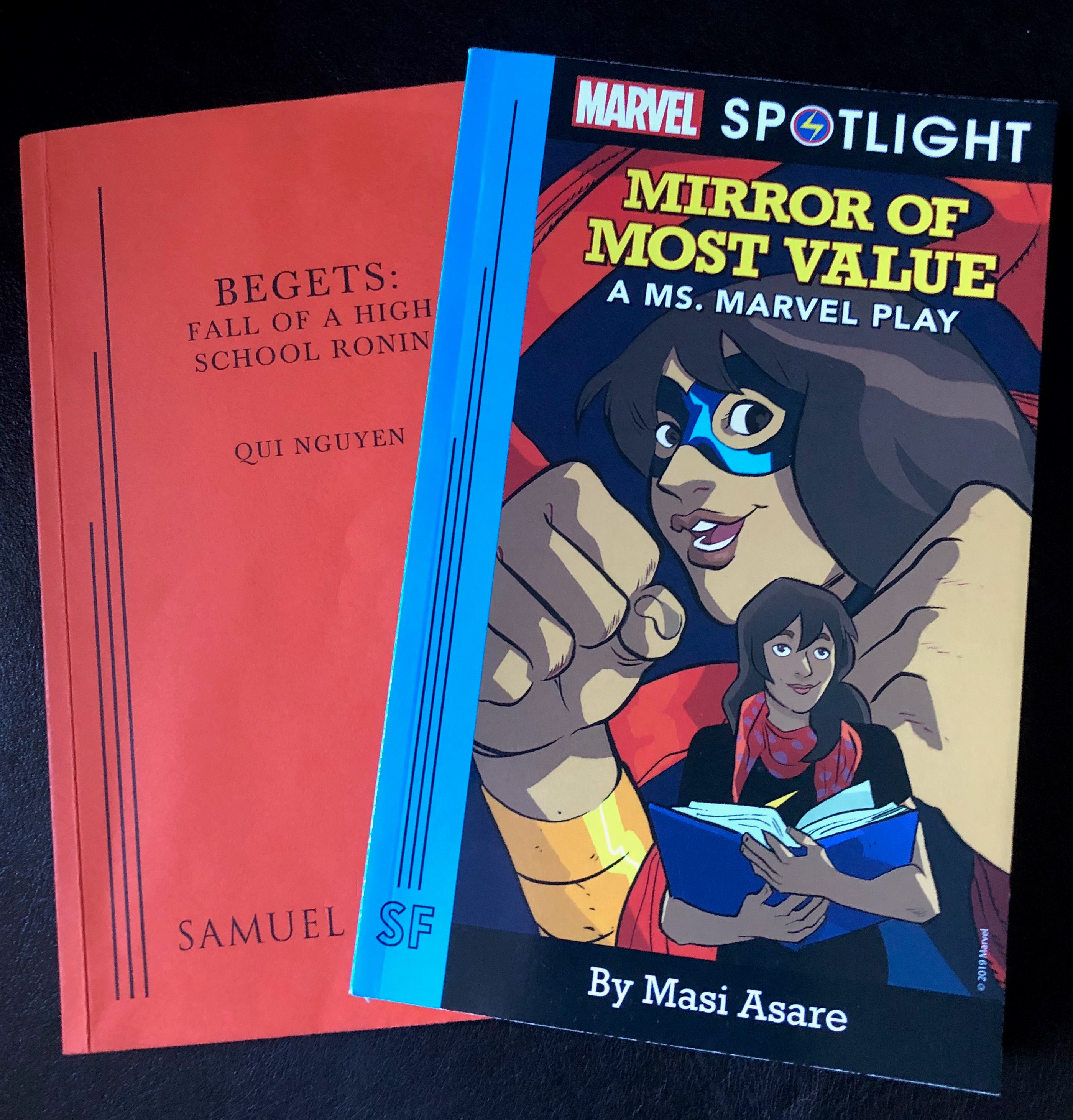 Mirror of Most Value Cover Art Comparison[/caption]
Mirror of Most Value Cover Art Comparison[/caption]
Look at how the Marvel Spotlight edition stands out next to another Samuel French script I recently bought (here’s my play overview of Qui Nguyen’s Begets: Fall of a High School Ronin). It features comic book colors, a fully illustrated cover, and of course, the Marvel logo.
When you’re a massive entertainment giant, there are a lot of people involved in the decision-making process. The credit page is packed with names:
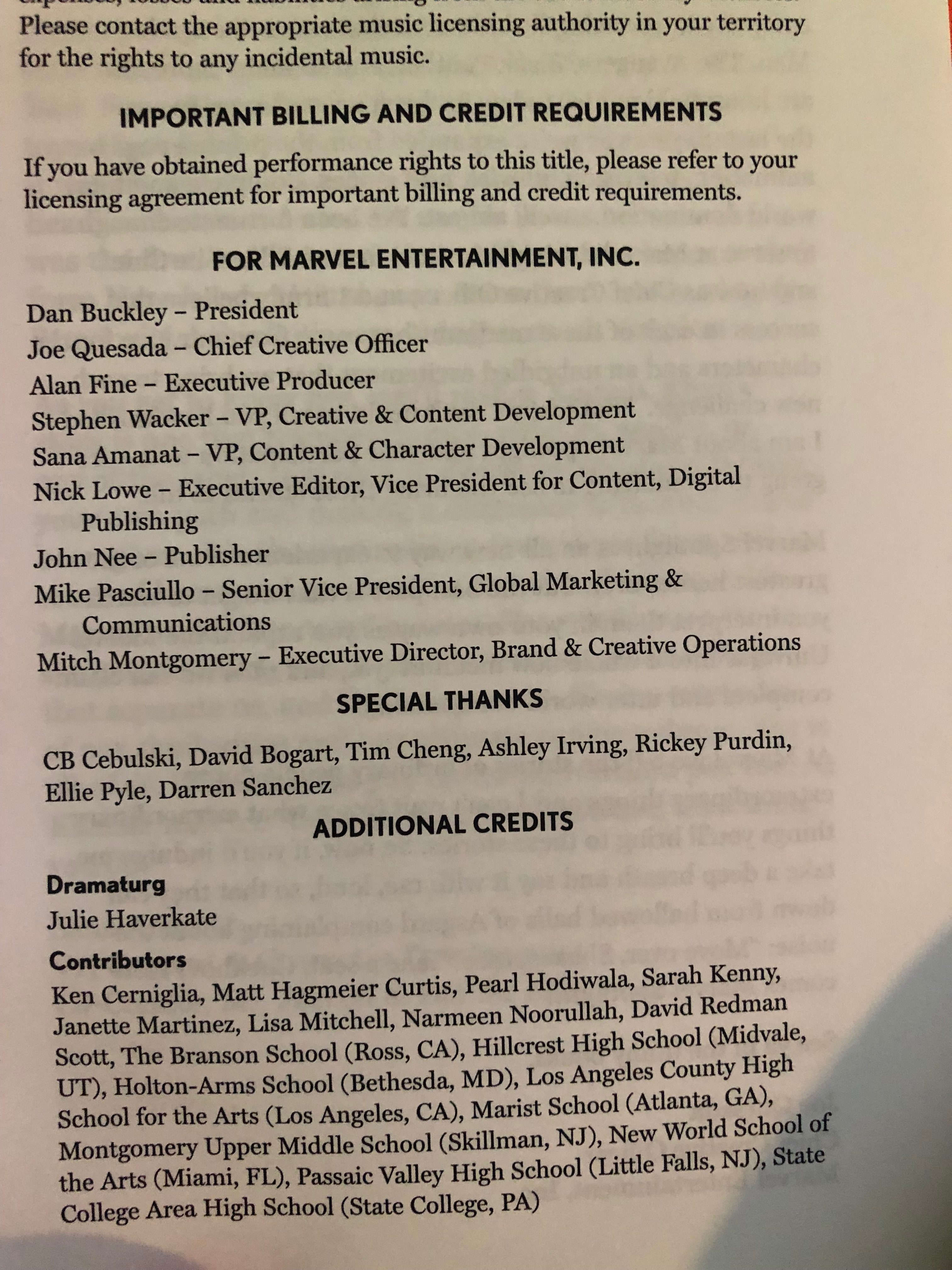 Mirror of Most Value credit page
Mirror of Most Value credit page
There are three titles in the Marvel Spotlight Series so far – Hammered: A Thor and Loki Play and Squirrel Girl Goes to College: A Squirrel Girl (and Tippy-Toe!) Play are the other two. (I have an overview for Squirrel Girl Goes to College here.)
Marvel commissioned two award-winning playwrights – Masi Asare and Karen Zacarías– and one award-winning actor (Christian Borle) to write the pieces for the series they’re calling Marvel Spotlight.
In conjunction with the writers, Marvel did a thorough job developing these titles for the educational theatre market. The plays are easily produced, with flexible casting both in number and gender. Samuel French deems the texts “appropriate for all audiences,” and cuttings are approved for competition.
Here are the sections included with two of the three scripts:
- “Origin” section explaining the super hero’s beginnings
- Casting notes
- Glossary
- Production Notes
- Rehearsal Discussion Starters
- Rehearsal Exercises
- Post-Show Talkbacks
- AND an Origin Sketch usable for a pre-show entertainment, or a publicity stunt for students to perform in advance of the show dates
All three plays in the Marvel Spotlight Series are one-act pieces – the running time for Mirror of Most Value: A Ms. Marvel Play is 45-50 minutes.
BACKGROUND
MS. MARVEL, the alter ego of Jersey City teenager KAMALA KHAN, is an Avengers-adjacent superhero with mutant powers caused by exposure to an otherworldly substance. She can lengthen her arms and legs, increase the size of her feet and fists, and has superhuman speed and strength (in her comic books, KAMALA has additional powers, but these don’t appear in Mirror of Most Value).
Captain Marvel (Carol Danvers) is KAMALA’s role model; Danvers was the first Ms. Marvel (before she became Captain Marvel). KAMALA admires the other Avengers as well.
The play is set early in KAMALA’s experience as MS. MARVEL; she’s still getting the hang of her powers and even being a superhero.
The Casting Notes as well as the Author’s Note point out that Kamala and her mother, Ammi, are Pakistani-Americans, and that “every effort should be made for them to be played by POC (people of color).” The Casting Notes warn Actors/Directors to avoid caricaturizing Ammi’s South Asian accent.
There is a doubling chart provided for a cast of 12; directors should also note that the script requires the following actors to double as Avengers in a dream sequence:
- JOSH as IRON MAN
- ZOE as BLACK WIDOW
- LEE as DOCTOR STRANGE
You can read more about Ms. Marvel/Kamala Khan on Marvel’s website.
THE SCRIPT
There’s an interesting twist to Mirror of Most Value which differentiates it from most superhero plots: there’s no “big bad.” KAMALA is patrolling the streets of Jersey City in several scenes, and foils some would-be criminals, but in each case, they’re “ordinary” robbery/burglary situations. There’s no evil villain character trying to take over the world that MS. MARVEL has to vanquish. Asare uses KAMALA’s internal conflict to drive the plot, featuring a series of factors weighing on her.
KAMALA feels pressure from:
- Her mom, AMMI, who wants academic excellence and an obedient, “good” daughter
- Her best friend, NAKIA, who wants KAMALA to be politically and socially engaged
- The “Public,” who is either ignoring her or giving biting and sometimes bullying commentary
- Herself, to be “super” in similar ways to her heroes the Avengers.
Concerned about MS. MARVEL’s lack of social media buzz, KAMALA creates several fan-fiction posts about her superhero patrols. The fanfic versions of herself are distanced from reality, but the witnesses are perhaps too harsh in their assessments of Ms. Marvel’s attempts at crimefighting. The ENSEMBLE gets to create these fanfic scenes as KAMALA types the story into her computer, then retell in “news report” style. They appear in juxtaposition to the ordinary daily life of a high school student; working on class projects, talking with friends, dealing with parents. Of course, KAMALA isn’t ordinary, but she tries to keep her identity as MS. MARVEL a secret from her mother, teacher, and friends. The only friend who knows about her identity as MS. MARVEL, BRUNO, seems to have resigned himself to keeping the secret while he moves on with a new girlfriend. though how he found out is not revealed in the script.
Ultimately, KAMALA’s challenge is to conquer her own feelings of self-doubt. On her quest, KAMALA gets dream messages from her female role models, AMMI and CAPTAIN MARVEL, that convince her to be honest with herself and write a reality-based adventure from her perspective. She also sees MS. MARVEL through the eyes of MS. NORRIS, her physics teacher who gets her purse snatched (and returned).
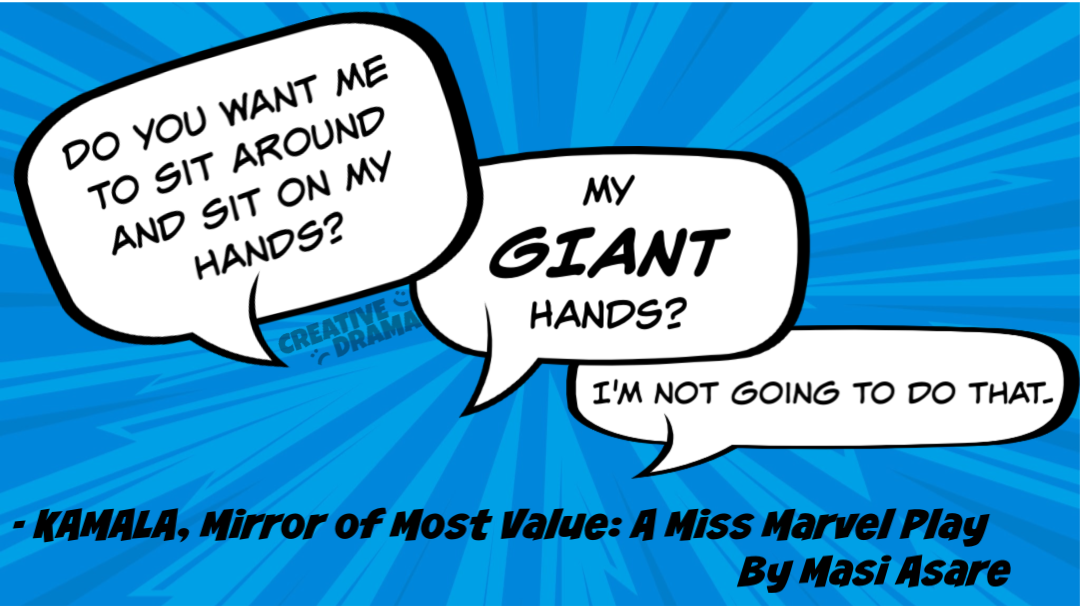
PAGE-TO-STAGE
There are several levels of narrative happening simultaneously in Mirror of Most Value: KAMALA’s day-to-day existence as a Jersey City teenager, her double life as MS. MARVEL, her fanfic recreations of her super adventures, and the view of the public, who aren’t necessarily fans of MS. MARVEL.
Actors playing characters from the Ms. Marvel comics will want to have their characters’ backstories in mind for their portrayals. There are significant past events that influence the characters’ choices; for example, BRUNO knows about KAMALA’s super powers and secret identity before the action of the play starts. The Casting Notes suggest that teacher-directors and their casts read Ms. Marvel, Volume One: No Normal; this will help with backstory and characters’ personalities.
The ENSEMBLE has unusual theatrical opportunities, creating the enlarged limbs of MS. MARVEL when she commands, “Embiggen!” and executing the ensuing stage combat.
With the fanfic narrative device, Asare gives more female actors more chances to perform (Yay!). A FANFIC MS. MARVEL acts out the story as KAMALA writes it, and this happens 3 times, so four different actors get the chance to “play” MS. MARVEL (the FANFIC MS. MARVELs are slightly different each time). It’s clear Asare understands the casting needs of educational theatre. The only time characters “have to” double is in a dream sequence when they go from being superheroes to people KAMALA knows in real life.
CONSIDERATIONS
I have assembled a VERY SHORT list of “Considerations” to help teacher-directors. These are aspects of the play that, in an ideal universe, wouldn’t cause a problem for a teacher-director. Mirror of Most Value: A Ms. Marvel Play should pass all but the very strictest of approval processes. But based on my experience and knowledge of past challenges to educational theatre pieces, these are things that an administrator, parent, member of the public, or a student could potentially object to OR request to change in the script.
I would hope that teacher-directors experience no challenges to Mirror of Most Value, but I think this list will help them be prepared “just in case.”
DON’T change the script without permission! See this Dramatists Guild initiative for more information.
#dontchangethewords
- KAMALA is a female superhero, so she breaks “traditional” gender roles by getting into physical altercations with criminals.
- KAMALA’s friend NAKIA (not to be confused with the Black Panther character) is a feminist and a political activist. The cause she’s fighting for in Mirror of Most Value is global female education; many of her lines communicate her frustrations with the patriarchy.
- There is no hint of these romantic feelings in Mirror of Most Value, but in later issues of the Ms. Marvel comics, ZOE develops a crush on NAKIA.
- There is some unresolved romantic tension between KAMALA and BRUNO; BRUNO admits to having had a crush on KAMALA in a conversation with GABE.
- BRUNO is dating MIKE (she’s female). There are no public displays of affection written into the stage directions.
- AMMI calls MS. MARVEL’s costume “skimpy clothing;” but in most comic panels I’ve seen, her outfit is modest in comparison to many other superheroes. She wears a tunic that looks similar to the South Asian kameez, although it’s a little shorter (covering her hips).
- Although there is some stage combat that happens in Mirror of Most Value, it is more comic than violent, and MS. MARVEL more often grabs the things being stolen than beats up the perpetrators.
- The language that some of the ENSEMBLE uses to describe MS. MARVEL’s crime-fighting is sometimes harsh and even cruel.

THE PLAYWRIGHT
Masi Asare is a playwright, lyricist, composer, and university professor whose work often focuses on families facing cultural challenges. She is the composer and lyricist of Sympathy Jones: The New Secret Agent Musical and the creator of The Family Resemblance
Dr. Asare is the recipient of many awards; you can read more about her on her Northwestern University faculty profile page. Dr. Asare teaches courses in musical theatre.
OTHER NOTES
Combining the play with the study of comic books would make for an interesting Literature/Visual Arts/Theatre arts integration unit. The Casting Notes suggest reading Ms. Marvel, Volume One: No Normal, so there’s a built-in text for comparison with the play.
Samuel French has several videos related to the Marvel Spotlight Series (scroll down).
Michael Scanlan’s Fortress and Stephen Gregg’s Sex Lives of the Superheroes are two other one-acts that have comic book themes – although the main characters themselves are not superpowered.
Samuel French has several videos related to the Marvel Spotlight Series (scroll down after following the link).
